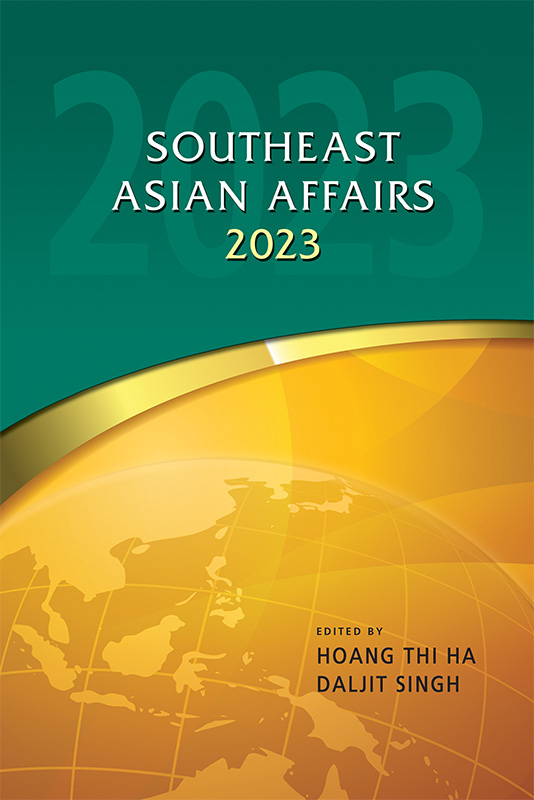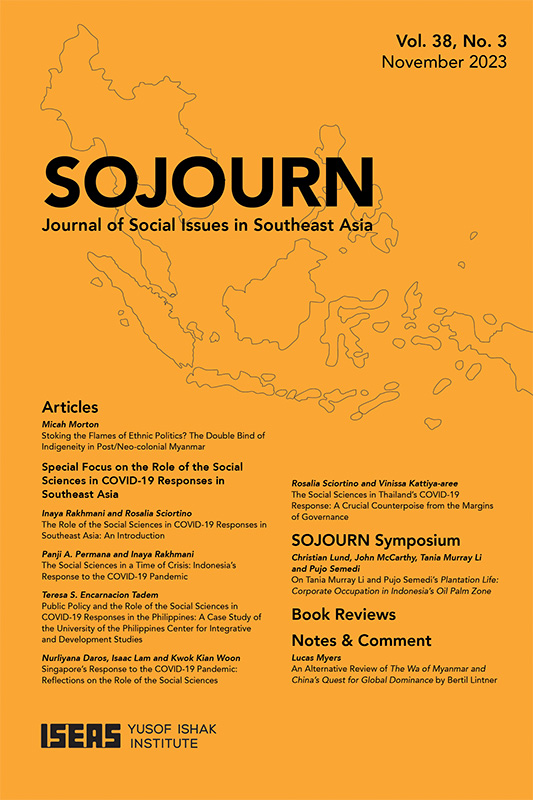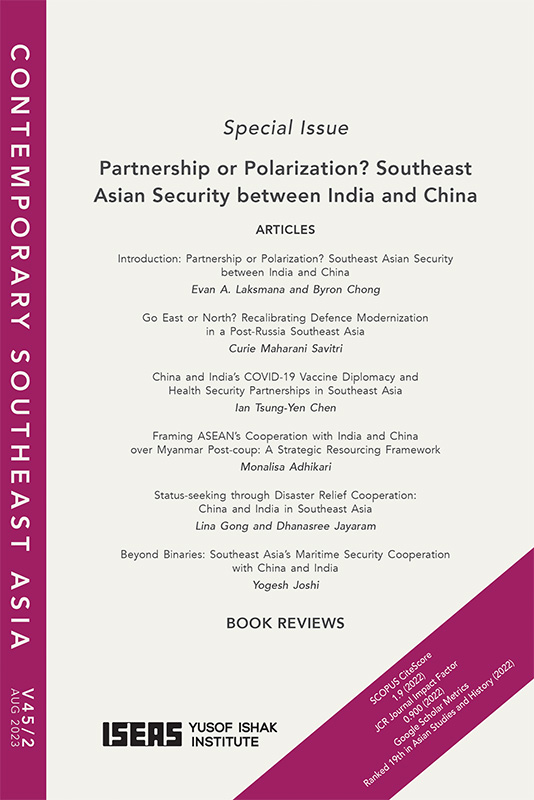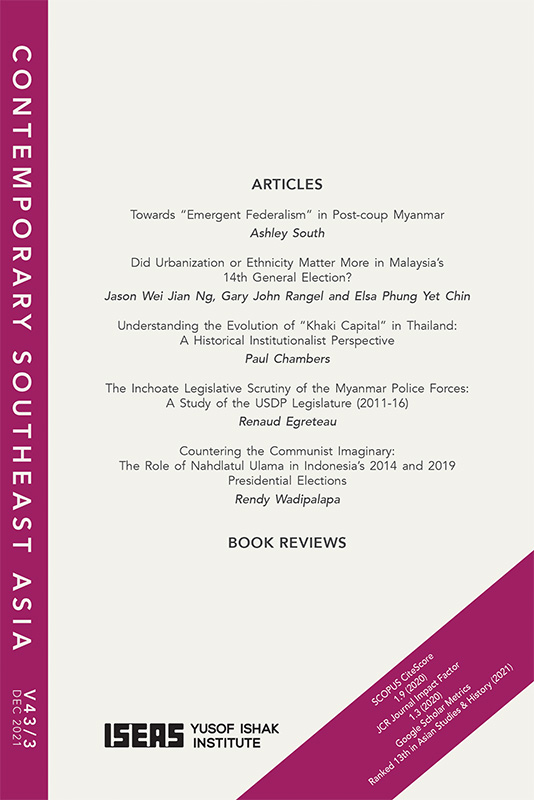Southeast Asian Affairs 2022
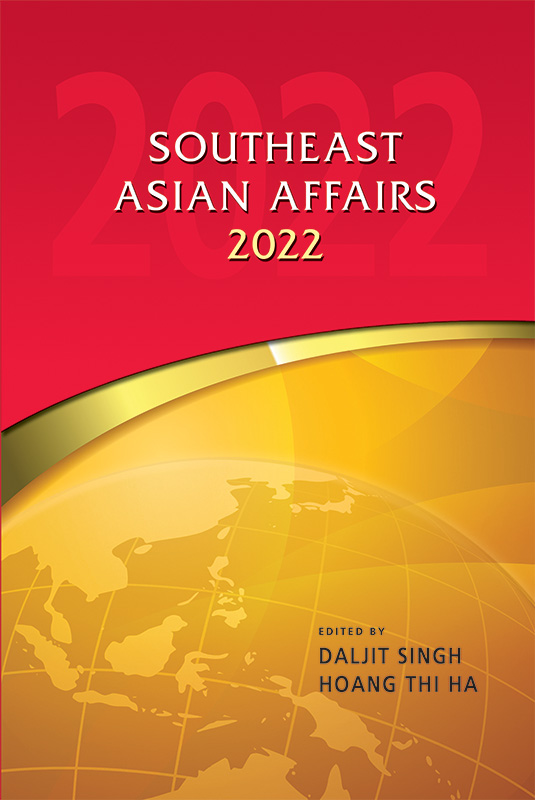
Date of publication:
2022
Publisher:
ISEAS – Yusof Ishak Institute
Number of pages:
410
Code:
SEAA22
Hard Cover
ISBN: 9789815011029
About the publication
“Southeast Asian Affairs, first published in 1974, continues today to be required reading for not only scholars but the general public interested in in-depth analysis of critical cultural, economic and political issues in Southeast Asia. In this annual review of the region, renowned academics provide comprehensive and stimulating commentary that furthers understanding of not only the region’s dynamism but also of its tensions and conflicts. It is a must read.”
– Suchit Bunbongkarn, Emeritus Professor, Chulalongkorn University
“Now in its forty-ninth edition, Southeast Asian Affairs offers an indispensable guide to this fascinating region. Lively, analytical, authoritative, and accessible, there is nothing comparable in quality or range to this series. It is a must read for academics, government officials, the business community, the media, and anybody with an interest in contemporary Southeast Asia. Drawing on its unparalleled network of researchers and commentators, ISEAS is to be congratulated for producing this major contribution to our understanding of this diverse and fast-changing region, to a consistently high standard and in a timely manner.”
– Hal Hill, H.W. Arndt Professor of Southeast Asian Economies, Australian National University
Contents
-
Southeast Asian Affairs 2022
[Whole Publication, ISBN: 9789815011036], by Daljit Singh, Hoang Thi Ha, authors -
Preliminary pages with Introduction
- THE REGION
-
Southeast Asia in 2021: A Year of Reckoning?, by Joseph Liow, author see abstractThe year 2021 proved to be a trying year for Southeast Asia on several fronts. Even as the region struggled to overcome the public health and economic challenges posed by the ongoing COVID-19 pandemic, it had to deal with the fallout from developments in Myanmar after the military seized power in February 2021. Meanwhile, relations with external powers evolved further as a new administration in the US refined its approaches and policies towards Southeast Asia and others enhanced their strategic, political, and economic interactions with the region.
-
Economic Outlook for Southeast Asia: Living with COVID-19, by Tham Siew Yean, Andrew Kam Jia Yi, authors see abstractSoutheast Asia has endured another year of the COVID-19 pandemic. Although there were surges in cases with the Delta variant in 2021, most of the economies have managed to weather this better than the first year of the pandemic. This is reflected in the improved growth performance in 2021, although it continued to be uneven across the countries in the region. For 2022, uncertainty will continue with the emergence of yet another variant. Prospects of recovery will also be influenced by the macro-economic management of each country. Funding the debt and fiscal deficit incurred over the last two years for battling COVID-19 will require regional countries to pursue tax reforms. Better tax administration and new sources of tax revenues are needed to fund the recovery process. Managing inflation and interest rate hikes will be another challenge. But there are two potential levers for improving growth performance. One is tapping on the improved trade and investment prospects with the ratification of the RCEP. The second is to ride on the digitalization momentum to bring forth changes that can transform the region and spur new growth sectors and development. Regional cooperation in the digital realm can also be used to hasten the change towards this direction.
-
Biden’s First Year: Coping with Decline as China Rises in Southeast Asia, by Robert Sutter, author see abstractThe remarkable negative shift in American policy against China dominates US policy in Southeast Asia and the broader Indo-Pacific region, one of two top policy arenas of acute US rivalry with China. The other is competition for dominance in the high technology industries determining which country will be the world’s economic and military leader. In both critical policy areas, the US seeks to counter Chinese challenges and prevent feared Chinese dominance and its negative impact on American security and wellbeing.
-
China's Role in Southeast Asia in 2021: Reassurance, Resolve, and Resurging Competition, by Chin-Hao Huang, author see abstractChina’s relations with Southeast Asia in 2021 saw continued advances in high priority efforts promoting regional economic integration, featuring ASEAN’s increasing importance as China’s key trade partner, and strengthening supply chain connections disrupted by the pandemic and US trade and economic restrictions. In its continued efforts to manage the COVID-19 pandemic, China has also stepped up its vaccine diplomacy, contributing more than sixty per cent of global vaccines to Southeast Asian countries. Nevertheless, a number of new and enduring challenges continue to complicate China’s foreign policy strategy in the region. The maritime dispute in the South China Sea heads the list of complications. Other security conflicts in the region include the unexpected coup and protracted crisis in Myanmar. Additional difficulty includes China’s recognition of the strategic challenge posed by the Biden administration’s efforts to re-engage the Indo-Pacific region through the Quadrilateral Security Dialogue (Quad) in the face of increasing tit-for-tat tension and competition with the United States.
-
Climate Change: Southeast Asia’s Existential Threat, by Sharon Seah, author see abstractClimate change is not an anticipated threat but a present and real crisis that is affecting Southeast Asia. Climate change has been consistently rated among the region’s top three security challenges. Yet national governments’ policies and actions are deemed insufficient by their populations. Regional governments’ Nationally Determined Contributions are unlikely to be achieved with present policies, much less transition the region to a low-carbon future. Long-term low emissions development strategies are at best merely aspirational targets dependent on a multitude of factors. It is imperative for the region to manage climate mitigation and adaptation challenges anticipated to arise from future economic growth and rising emissions by planning for an orderly, systematic energy transition and accelerating the scale and speed of the region’s climate adaptation actions. There is cause for cautious optimism with changes on the horizon that may lay the ground for change in the region.
- BRUNEI DARUSSALAM
-
Brunei Darussalam in 2021: The Battle against COVID-19 and a Year of Short-Lived Optimism, by Jatswan S Sidhu, Jörn Dosch, authors see abstractOptimism derived from the initially successful containment of the COVID-19 pandemic in Brunei was short-lived as new infections hit the country like a tsunami in the second half of 2021. Strict restrictions that had earlier been relaxed were reintroduced. Amid the ongoing battle against COVID-19, Brunei assumed chairmanship of ASEAN in January 2021. The military coup in Myanmar in February put Brunei in a tight spot as all eyes were on ASEAN’s reaction to the crisis. Although an unusually bold decision was made to exclude Myanmar from the ASEAN Summit in late October hosted virtually by Brunei, on other occasions the ASEAN chair appeared to be lending legitimacy to the military regime. Apart from addressing the issue of low growth rates because of overdependence on oil and natural gas, rising unemployment remains a major concern for the sultanate. In realising economic diversification, a new blueprint Towards a Dynamic and Sustainable Economy, unveiled in January, emphasises the emergence of a strong private sector in Brunei. As a further move, the sultanate plans to nurture a digital economy. Brunei maintained close security and defence relations with its traditional partners in 2021. The year also marked the 30th anniversary of the establishment of relations between Brunei and the People’s Republic China (PRC). The PRC is Brunei’s largest foreign direct investor and has pledged to increase its investments, especially under its Belt and Road Initiative.
- CAMBODIA
-
Cambodia in 2021: A Year of Ongoing Domestic Challenges and Western Pressure, by Jing Jing Luo, Kheang Un, authors see abstractLike many countries around the world, Cambodia continued to be hard hit by the COVID-19 pandemic in 2021. Socio-economic impacts resulting from and the government’s responses to the pandemic, combined with rising Sino-US geostrategic competition, provided an opportunity for banned opposition Cambodian National Rescue Party (CNRP) to reactivate its cells inside Cambodia and lobby Western governments in an effort to have the CNRP reinstated as a legal political party. In foreign relations, while 2021 saw ever closer Sino-Cambodian relations, tensions grew between the country and the United States. This chapter analyses the aforementioned challenges in three sections. The first discusses the spread of the COVID-19 pandemic, the government’s responses and its impact on the economy. The second analyses the efforts of the CNRP to stage a comeback and the ruling Cambodian People’s Party’s reactions. The third discusses Cambodia’s foreign relations focusing on the ever-closer Sino-Cambodian relations and its benefits for Cambodia, US pressure on Phnom Penh over its close ties with China and democratic backsliding, and Japan’s continued engagement to counter-balance Chinese influence in the country.
-
Walking a Fine Line: How Cambodia Navigates Its Way between China and Vietnam, by Bradley J. Murg, author see abstractCambodia’s relationships with China and Vietnam over the last decade have been subject to two distinct yet fundamentally opposing narratives. For many Western and ASEAN analysts, Cambodia is often simply perceived as a vassal state of China—prepared to do Beijing’s bidding in light of the enormous amount of aid and investment flowing south from its near northern neighbour. Conversely, the prevailing, historical narrative among many opposition activists in Cambodia and the Cambodian diaspora maintains that the kingdom is a vassal state of Vietnam, with Hanoi in control of Cambodian policy. Reviewing events over the course of the 2020–21, this chapter contends that the reality is more complex. Cambodia has and continues to balance strong relationships with both partners to reap significant economic and political benefits. This is despite the deep fissures in Sino-Vietnamese relations that continue to grow amid intensifying competition in the region between the United States and China. Prior work—particularly that of Steve Heder on Cambodia-Vietnam military ties, which is critical to Prime Minister Hun Sen’s regime security—remains valid in understanding the complexities of Phnom Penh’s position vis-à-vis Beijing and Hanoi.
- INDONESIA
-
Indonesia in 2021: In the Eye of the Storm, by Sana Jaffrey, author see abstractIn 2021 Indonesia became the epicentre of the COVID-19 pandemic as a devastating wave of infections engulfed the country, fuelled by a mix of data denial and governance dysfunction. The Delta-wave caused a health system collapse and public trust in President Jokowi’s ability to manage the pandemic declined. With an eye on the 2024 elections, political parties used the pandemic to score points with their constituents by distributing government-bought vaccines to their supporters. In the middle of the raging health crisis, the Indonesian Parliament passed a new Special Autonomy Law for Papua that transfers key fiscal and political powers back to Jakarta, effectively ending Papuans’ ability to govern themselves. The Indonesian economy is finally showing signs of recovery on the back of a global commodities boom and strong domestic demand. Timely expansion of the social assistance program also mitigated poverty impact of the Delta-wave. But as the pandemic drags on, critical uncertainties loom ahead.
-
Terrorism and Extremism in Indonesia and the Southeast Asian Region, by Sidney Jones, author see abstractThe threat of terrorism in Indonesia remained at a low level as police used a strengthened anti-terrorism law to make "preventive strikes". Pro-ISIS groups remained the major source of violence but lacked skills and leadership to mount major attacks, though several autonomous cells made the effort to do so. Women continued to be attracted by the idea of martyrdom. While two were killed in foiled attacks, others volunteered as suicide bombers. Looking ahead, the danger is more from within Indonesia than from external developments such as the Taliban takeover in Afghanistan. Indonesian police need to be alert to the consequences of their new powers of arrest. As of late 2021, the criminal justice system was stretched to the limit with overcrowded prisons, overburdened prosecutors and judges, and new grievances that could aid the process of regeneration within terrorist organisations and facilitate the emergence of more militant splinters.
- LAOS
-
Laos in 2021: (Im)mobility with Infrastructure and COVID-19, by Phill Wilcox, author see abstractThe year 2021 began with Laos as a rare success story of managing the pandemic, but this changed in April when COVID-19 appeared in Laos, leading to a succession of lockdowns and COVID-19 measures that are starting to reduce only at the time of writing with the end of the year in sight. In addition to COVID-19, there have been other significant developments, not least the completion of the Laos-China Railway, which is set to open for passenger transport in December 2021. In addition, the year has been marked by economic woes, which have been exacerbated by the fallout from the pandemic.
- MALAYSIA
-
Malaysia in 2021: Another Regime Change and the Search for Malay Political Stability, by James Chin, author see abstractThe year 2021 marks another tumultuous one for Malaysia. There was the fall of the Perikatan Nasional government under Muhyiddin Yassin, who was replaced by Ismail Sabri of the United Malays National Organisation (UMNO). State elections were held in Melaka and Sarawak: UMNO made a big comeback in Melaka, while the Gabungan Parti Sarawak won easily in the state as expected. The impact of the COVID-19 pandemic meant the economy was still in recovery mode, while the passage of the 2022 budget was mired in controversy over its overt emphasis on the Malay community. The infighting between the two major Malay parties of the ruling coalition—UMNO and the Parti Pribumi Bersatu Malaysia—was the main cause of political instability in the country for much of the year.
-
Malaysia’s Relations with the United States and China: Asymmetries (and Anxieties) Amplified, by Kuik Cheng-Chwee, Thomas Daniel, authors see abstractThis essay traces recent developments in Malaysia’s asymmetrical relationships with the United States and China. It argues that while Malaysia has responded prudently to the escalating US–China rivalry and uncertainties, some aspects of its policies have raised anxieties internally and misinterpretations externally. This is attributable primarily to its elites’ internal preoccupations, policy indecisiveness, and bureaucratic inertia.
- MYANMAR
-
Myanmar in 2021: A State Torn Apart, by Morten B. Pedersen, author see abstractThe 1 February 2021 military coup in Myanmar ended a decade of political liberalization and triggered a countrywide popular uprising, which soon turned into armed resistance and ultimately all-out civil war. By year’s end, the military was locked in a battle for survival with a wide range of resistance forces from nearly every sector of society, while the state and economy were collapsing, and millions of people faced a deepening humanitarian emergency. The international community fretted about the growing crisis and demanded that the violence stop but was ultimately unable to do much more than watch as Myanmar fell apart.
-
Myanmar’s Eonomy in 2021: The Unravelling of a Decade of Reforms, by Romain Caillaud, author see abstractThe military coup of 1 February 2021 and the ensuing political crisis have wrecked Myanmar’s mid-term economic development prospects. As the new junta persists with its political roadmap despite widespread domestic and international resistance, economic costs are set to mount. These costs come on top of those created by the COVID-19 pandemic, thus affecting an already fragile economy. It remains to be seen how worse the economic and humanitarian situation will get, including to what extent economic and business reforms of the last decade will be overturned.
- THE PHILIPPINES
-
The Philippines in 2021: The Decline of the House of Duterte?, by Paul Hutchcroft, Ronald Holmes, authors see abstractAfter several years in which the rule of President Rodrigo Duterte seemed nearly invincible, by the end of 2021 he began to lose his grip over events critical to his future. Although his approval ratings remained very high, the country’s supremo faced the prospect of going into the May 2022 elections without his own “anointed” candidate. His apparent plan was to convince his daughter Sara to follow his lead and move from the Davao City mayoral post to the presidency—from which position she would be able to shield him from potential prosecution for the thousands killed in his so-called “war on drugs”. In the midst of an intra-familial spat, however, Sara teamed up with Ferdinand Marcos, Jr., the offspring of the “conjugal dictatorship” that ruled the country from 1972 to 1986. This chapter chronicles the extraordinary dynamics that produced this outcome, while also surveying the country’s challenges with pandemic management; tentative economic recovery; and seeming shifts back towards a more traditional foreign policy stance. We close by examining the continuing—perhaps soon worsening—threats to the viability of Philippine democracy.
-
Hobbesian Flirtation and Viral Entanglements: Shifts in Philippine Civil-Military Terrain under the Duterte Administration, by Rosalie Arcala Hall, author see abstractCivil-military relations under the Duterte administration brought to prominence presidential control over the military. Absent checks by Congress and the Supreme Court, frequent domestic military deployments for anti-terror operations, the implementation of martial law, and support to law enforcement including the COVID-19 pandemic response embedding the armed forces further into civilian tasks and institutionalizing their imprint in local security decision-making. Duterte’s partiality towards the military as his administration’s go-to apparatus for problem-solving has brought deleterious long-run consequences to the former’s professional mooring and potential dangers to civil liberties.
- SINGAPORE
-
Singapore in 2021: Navigating through Domestic and Global Crises, by Leong Chan-Hoong, author see abstractSingaporeans will remember 2021 as a year of surprises, contestations and a loss of national innocence. While COVID-19 continues to ravage economic confidence and public health, Singapore, like other countries, rolled out a comprehensive national vaccination exercise at the start of the year that brought partial reprieve to the disruptions from the coronavirus. Some of the pre-COVID activities such as international air travel and social and business gatherings have resumed, and rightly so, as these activities are crucial ingredients for economic survival in trade dependent, small states like Singapore. The respite has been short lived, however, as new coronavirus variants surface over time, putting the public healthcare system under strain. And the pandemic is not the only crisis Singapore has had to put up. Amid the rising tension in US-China relations, the city-state has had to walk a tightrope and avoid taking side. On the domestic front, the city-state was rocked by a series of racial and nationalism-based conflicts, which have exposed Singaporeans’ latent discomfort and social fractures. This article will first offer an overarching review of the key economic, political and social events in the city-state, followed by an analysis of the undercurrents and what they will mean to Singapore in the years ahead.
-
Race and Racism in Singapore, by Terence Chong, Khairulanwar Zaini, authors see abstractIt is the fate of multicultural Singapore to be saddled with the complexities of race and racism. These complexities will not disappear because of the inherent and primordial nature of people to seek group membership as well as our ever-evolving views on race. Singapore’s openness to the world also means that debates over race and racism in other countries and contexts will invariably influence local discussions about racial issues. This chapter reviews the incidents of racism in Singapore in 2021 and takes stock of interethnic relations in the country. It asks if racism is a growing problem or if such incidents have been amplified by social media. It surveys foreign concepts like Critical Race Theory and derivatives like “Chinese privilege” to assess their relevance to local issues, especially in light of the not insignificant local pushback against these ideas. The conclusion explores how to move forward with regards to discussions of race and racism in Singapore.
- THAILAND
-
Thailand in 2021: Angling towards Chaos?, by Paul Chambers, author see abstractIn 2021 the Thai state continued to be challenged by the COVID-19 pandemic, youth-led demonstrations against limited democracy, an economic morass, and government attempts to achieve a balanced foreign policy between China and the United States. By the end of the year, the dominant military proxy Palang Pracharat Party had become mired in internal conflict. Nevertheless, ex-army commander-turned-prime minister Prayut Chan-ocha remained head of government.
-
Thailand's Monarchy in Crisis: The Tenth Reign, by Bruce Lockhart, author see abstractThe 2020–21 protests in Thailand have articulated an unprecedented degree of dissatisfaction with the monarchy, including concrete calls for its reform. The present crisis is partly a result of decisions made by King Vajiralongkorn. At the same time, however, it is rooted in the reign of his late father Bhumibol, when the monarchy was built up into a powerful institution that operated largely beyond the bounds of its constitutional prerogatives.
- VIETNAM
-
Vietnam in 2021: Leadership Transition, Party-Building and Combating COVID-19, by Carlyle A. Thayer, author see abstractThis chapter provides an overview of three major developments in Vietnam in 2021. First, in January the quinquennial national congress of the Vietnam Communist Party elected a new Central Committee that reappointed General Secretary Nguyen Phu Trong for an unprecedented third term and recommended a reshuffle among top government leaders, subsequently approved by the National Assembly. Second, General Secretary Trong continued to implement his party-building campaign by taking disciplinary action against ranking national, municipal and province-level party officials. This campaign, however, raised more questions than it answered. Was this just the tip of the iceberg? Notably, General Secretary Trong revised an important party regulation that enumerated nineteen activities that party members should not do. Third, Vietnam paid a major price for not prioritizing COVID-19 vaccinations before the Delta variant spread to Vietnam killing nearly two million people. After implementing draconian lockdown measures, public support for the government declined markedly. The government then abandoned its Zero COVID policy in favour of a strong national vaccination campaign. At year’s end the COVID pandemic was brought under control, public health restrictions eased, and economic activity resumed.
-
Upgrading Vietnam's Participation in the Global Value Chains, by Can Van Luc, author see abstractUpgrading Vietnam’s participation in the global value chains (GVC) has become a matter of national concern for the past two decades. Vietnam’s international economic integration over the years has attracted a growing number of foreign investors to the country, many of which are large multinational corporations (MNCs). As a result, Vietnam has become an integral part of the GVC in many industries such as electronics, textiles, agriculture and consumer goods, contributing to the country’s strong export growth. Participation of its domestic businesses in the GVC, however, remains very modest as they mainly focus on simple processing activities for popular products with low-added value. Significant challenges for the country include its predominantly backward GVC participation, its declining forward GVC participation, weak supporting industries, and GVC participation’s heavy dependence on FDI enterprises. This study assesses Vietnam’s current position in the GVC map, identifies development trends that present both opportunities and challenges for the country, and suggests policy directions for Vietnam’s drive to move up the ladder in the GVC.


